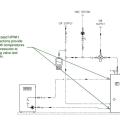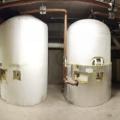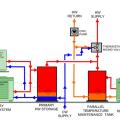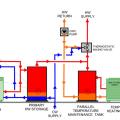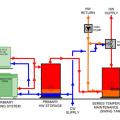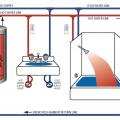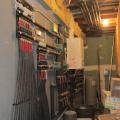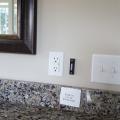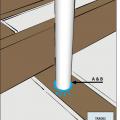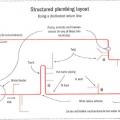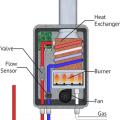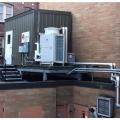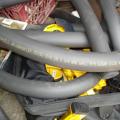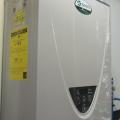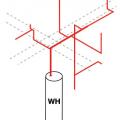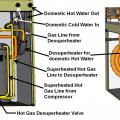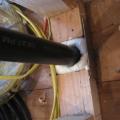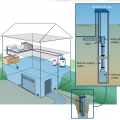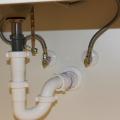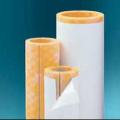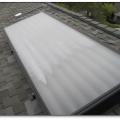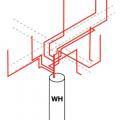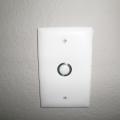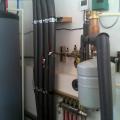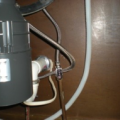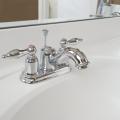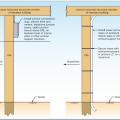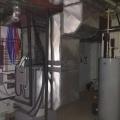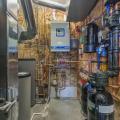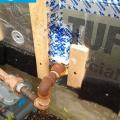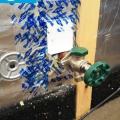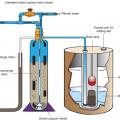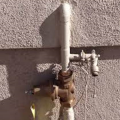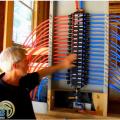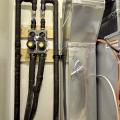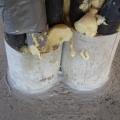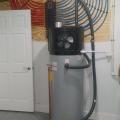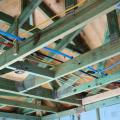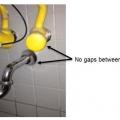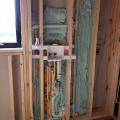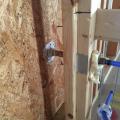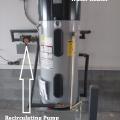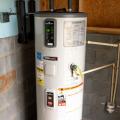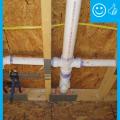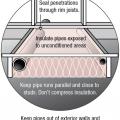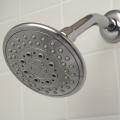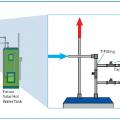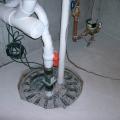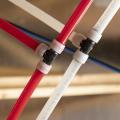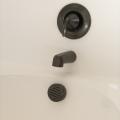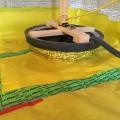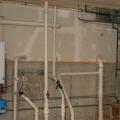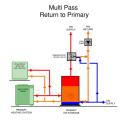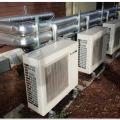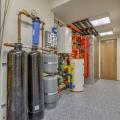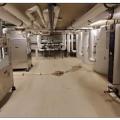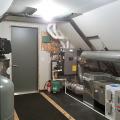Showing results 1 - 100 of 135
Right: dedicated tank connections for HPWH inlet and outlet provide hydraulic separation
A central heat pump water heating system with a parallel loop tank temperature maintenance configuration uses a multi pass heat pump water heater to provide all the heat for hot water circulation temperature maintenance.
A central heat pump water heating system with a parallel loop tank temperature maintenance configuration uses a multi-pass heat pump water heater to provide all the heat for hot water circulation temperature maintenance
A central heat pump water heating system with a temperature maintenance swing tank configuration uses the water from the primary storage tank to provide most of the heat for hot water circulation temperature maintenance
A demand plumbing layout uses a recirculation pump to speed delivery of hot water to plumbing fixtures.
A high-efficiency gas boiler provides hot water to the faucets, to radiant heating loops in the basement floor, and to a hydro-coil for a central air heating system.
A push button operates the on-demand hot water circulation pump in this master bathroom.
A water softener collects water, filters it to remove minerals, and then sends it to the home's plumbing distribution system
Air-seal around all plumbing and piping installed through walls, ceilings, and flooring adjacent to unconditioned space to prevent air leakage.
All components of the recirculation system should be included in the plumbing layout.
All of the pipes are insulated on this high-efficiency 50-gallon heat pump water heater.
Basic components of a gas tankless water heater include a high-powered burner, fan, and heat exchanger; condensing gas water heaters also have a secondary heat exchanger and a piped air intake to the sealed combustion chamber
Central heat pump water heaters like this fully packaged system provide efficient, reliable domestic hot water for multifamily buildings; storage tanks are within the enclosure, and the heat pump is seen just outside.
Compare gas tankless water heater efficiencies on the Energy Guide labels or look for the ENERGY STAR label
During drought periods, an integrated back-up system adds city water to maintain the Durable Energy home’s 11,500-gallon cistern at 25% capacity or more.
For homes built in high probability flood zones, move all possible plumbing equipment above the Base Flood Elevation (BFE), shown here as “Flood Protection Level;” equipment that cannot be moved should be watertight to resist floodwater
High-density fiberglass pipe insulation comes with a vapor barrier cover and self-adhesive seam
Hot and cold water hose connections and valves are common sources of leaks at kitchen and bathroom faucets.
Install WaterSense® labeled showerheads which can reduce water use in the shower by 20 percent.
Integrate pre-formed vent pipe flashing, shingle-fashion, with roofing underlayment and shingles
On-demand hot water pumps speed hot water to faucets at a push of a button to limit water waste and save energy.
Pipe insulation helps retain heat in the pipes which provide hot water from the air-to-water heat pump for domestic hot water and space heating.
Plumbing penetrations through the below slab insulation are sealed with tape and spray foam.
Plumbing pipes that pass through top plates can be air-sealed with a gasket material cut slightly smaller than the pipe diameter.
Properly install all water-using fixtures, equipment, and appliances such that there are no leaks.
Recommended installation techniques for electrical and plumbing lines and other utility components in homes built on piers above the base flood elevation.
Right - A home-run (also called central manifold or parallel piping) system distributes hot water directly from a distribution manifold next to the water heater to each fixture using individual small-diameter PEX pipes.
Right - EPA WaterSense-rated low-flow plumbing fixtures are verified as using less water than typical plumbing fixtures.
Right - Metal drip edge flashing is installed above hose bib and top of metal flashing is taped to wall.
Right - Peel and stick flashing and flashing tape seal a plumbing pipe that penetrates an exterior wall.
Right - Pressure reducing valves installed outside the home reduce water pressure before water is distributed to fixtures.
Right - The geothermal heat pump provides hot water for radiant floor heating, domestic hot water, and the air handler for space conditioning upstairs.
Right - The home’s high-efficiency gas boiler provides domestic hot water as well as in-floor radiant heat, while a high-efficiency heat pump provides cooling and a secondary source of heating.
Right - The pipe penetration is properly flashed and furring strips are installed on each side in preparation for installing cladding
Right - The water and air control layers are properly integrated around the hose bib
Right - This water softener filters hard water through a mineral-collecting medium before delivering water to the main plumbing system.
Right - Water pressure reducing valves should be installed prior to fixture piping such as where water enters the home.
Right – A builder of a DOE Zero Energy Ready certified home explains how a central manifold distribution system with PEX piping works.
Right – Adequate space is provided near the air handler for the water lines of this ground-source heat pump.
Right – Hot water from this heat pump water heater is distributed efficiently to each hot water use in the home through a central manifold via PEX piping.
Right – PEX piping speeds hot water directly from the water heater to faucets through the attic in this slab-on-grade home.
Right – Plumbing pipes have flanges that are sealed to the wall with caulk to prevent pest entry
Right – Spray foam is used to carefully seal behind plumbing that was installed in an exterior wall.
Right – Tape and spray foam are used to air seal around pipes that extend through exterior walls.
Right – The heat pump water heater is equipped with a recirculating pump to push hot water to distant fixtures.
Right: Maintenance valves are installed at the inlet and outlet of this central heat pump water heater
Showering accounts for 1.2 trillion gallons of water per year in the United States.
Spray foam insulation insulates and air seals around plumbing pipes and top plates in the attic.
The pipe connections for faucets, dishwashers, garbage disposals, and other water using appliances can be a source of leaks.
The shower diverter in bath/shower combinations is one of the common sources of leaks in tub faucets.
The sump pump is sealed to the subslab vapor barrier with sealing tape to prevent soil gas from leaking around the sump bucket.
The sump pumps in this basement are covered with gasketed lids to keep soil gases out of the home.
The very high efficiency (4.7 COP) ground-source heat pump provides hot water to a tank for radiant floor heat and domestic hot water.
This central heat pump water heating system with a hot water circulation loop that returns to the primary storage tank relies on a single pass heat pump to provide both primary DHW heating and hot water circulation temperature maintenance
This central heat pump water heating system with a hot water circulation loop that returns to the primary storage tank relies on a multi pass heat pump to provide both primary DHW heating and hot water circulation temperature maintenance
This fully packaged/skid-mounted central heat pump water heating system was shipped to the building on a truck and craned into location
This fully specified central heat pump water heating system has four individual outdoor heat pump units plumbed in parallel to indoor storage tanks
This home is piped with an insulated hot water recirculation loop that speeds hot water to each fixture while helping to reduce water waste.
This home’s domestic hot water is provided by three systems: solar water heating panels, a heat pump water heater, and an air-to-water heat pump, which also provides hot water to a fan coil.
This mechanical room contains both the storage tanks (right) and heat pumps (left) of a central heat pump water heating system
This packaged central heat pump water heating system has the heat pumps on the exterior of the blue enclosure, and the storage tanks, temperature maintenance equipment, mixing valve, and control modules on the inside
This plumbing pipe is wrapped with a stainless steel mesh skirt that is clamped to the pipe before the concrete slab is poured to to keep out bugs and rodents
This retrofit central heat pump water heater system utilizes the existing water heater as a swing tank to provide temperature maintenance for the hot water circulation loop
This utility room houses a high-efficiency gas boiler to provide hot water for the radiant floor heating system and faucets. It also has a central air source heat pump and an energy recovery ventilator.
This wall-mounted high-efficiency condensing gas tankless water heater has PVC vent pipes and insulated water pipes
